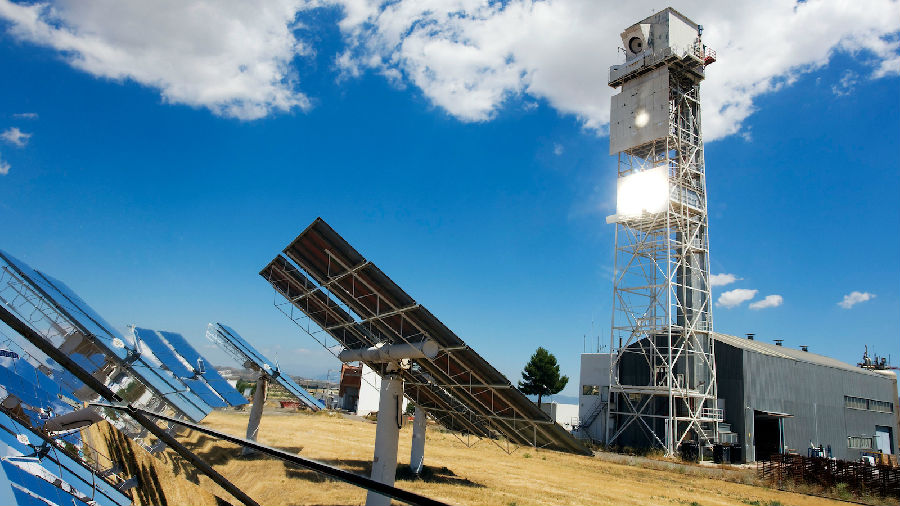Home > Market > Other Regions > Here
Experts: Most Efficient Solar to Split Water to Hydrogen is CSP
2017.12.21 From: SolarPACES

Thermochemical solar leverages heat from concentrated solar power (CSP) for chemical
reactions. Research into thermochemical solar reactors to split water
to hydrogen is a priority in top national laboratories internationally.
What part will thermal solar play in a future hydrogen economy?
To get an overview, we checked with a top solar hydrogen expert, Christian Sattler, who holds 18 patents and has authored 158 peer-reviewed papers. Sattler sums international research in: Concentrated Solar Radiation: More than just a power source. He heads the Department of Solar Chemical Engineering at the Institute of Solar Research at Deutsches Zentrum für Luft- und Raumfahrt, the German Aerospace Center (DLR).
What is the advantage of solar reactors over solar electrolysis?
Our colleagues have calculated that probably the most efficient way to produce solar hydrogen leverages solar heat for a thermochemical reaction. There are overall efficiency advantages. When electrolysis is powered by solar photovoltaic an efficiency of only 12 percent to 14 percent is reported.
For the thermochemical water-splitting reaction, some solar reactor systems have efficiencies of over 60 percent. The two-step solar thermochemical conversion is still subject to research, but shows a long-term efficiency potential of up to 25 percent.
However, there are also market-driven, industry-driven reasons to use electrolysis. In Germany we have wind power at a time we can’t use. Big utilities operating these wind plants lose billions of euros every year, so we need to store that fluctuating energy.
Even if you have a less than efficient electrolyzer, and you can keep half of the electricity stored in your hydrogen to reuse for power when it is necessary, that is still cheaper than wasting it.
Tip:- Find all international SolarPACES
solar hydrogen research at this site by
keyword searches: ‘reactor’ or ‘hydrogen’
How is solar thermal energy used to split water to make hydrogen?
Heat drives many chemical reactions. Hydrogen is produced now by combustion of natural gas, to chemically pull hydrogen out of a hydrocarbon at a temperature of 800°C to 900°C. Both steps create carbon dioxide emissions.
But in solar thermal (heat) energy, thousands of “suns” can be concentrated by mirrors and focused into a solar reactor to produce temperatures up to 1,500°C. There are no carbon emissions when hydrogen is made by a thermochemical reaction splitting water using the heat of a solar reactor.
When hydrogen is made with solar energy instead of natural gas, the feedstock is water, not a fossil fuel. Solar heat at about 800 C makes the water (H2O) split into hydrogen (H2) and oxygen (O).
Could natural gas plants be converted to hydrogen?
Yes. Converting from natural gas to hydrogen power stations is actually the major part of the 40-year Japanese hydrogen energy economy plan. The turbines are developed by the major companies in Japan, the USA and Germany. Mitsui’s Ayako Matsumoto has an excellent presentation on the Business Potential of Solar Hydrogen.
Because hydrogen has some special behaviors with metals, you need to pick a turbine that would withstand the hydrogen. So hub parts in the turbine where the hydrogen is fed in need to be coated with ceramic film or an oxide that is a protection layer so that no hydrates are formed, so the hydrogen is not degrading the metal.
Siemens and General Electric have a joint venture on that and their turbines will be about 100 MW. So it is not science fiction. The turbines are ready; the technology is about to be ready.
Could hydrogen power big ships and commercial planes?
Definitely. There is a first ship in Norway, a ferryboat with a 1,000 horsepower engine running on hydrogen due in 2020. Viking Cruises announced its first hydrogen ship in September. There’s also a joint venture between Shell and Kawasaki, they have already built several hydrogen tankers, different from LNG tankers, for transporting hydrogen. Japan is implementing a 40-year plan to get to a hydrogen economy.
Hydrogen planes flew already in the 1980s, in Russia in the Soviet Union. There were other smaller test planes also operating and there was a design for a big Airbus with a large hydrogen tank on top of the cabin so it is possible.
From a safety point of view, people in the airline industry say hydrogen would be safer than liquid fuel that can ignite when something happens, while hydrogen is gone instantly. However, hydrogen is difficult over the next 20 or 30 years because of existing airport infrastructure and regulations. Carbon-based fuels for airplanes are difficult to replace in the next several decades.
Alternatively, we can make solar jet fuel, by splitting both H2O and CO2 in a solar reactor. In the SOLAR-JET project, Luftfahrt’s assessment confirmed that for any reasonable aviation fuel demand a small fraction of the world’s desert area would provide sufficient sunlight.
What might commercial hydrogen solar reactors look like?
Experimentally, solar reactors range from 1 meter to 5 meters to demonstrate the concept or as pilot projects, depending a little on the technology. For large-scale fuel production we foresee that a solar hydrogen plant will be much bigger, like a 100 MW solar tower. And like today, these large chemical plants will be a bit further away. They need to be protected. Like a refinery it will not be in your backyard.
At commercial scale most likely you would not build one big reaction chamber but have several smaller chambers close together, at about that size that we have today, at the top of the tower.
Probably you would have a steam generator. There is not much water that you need. You’d pump water through and evaporate it and get the steam into the reaction chamber and hydrogen comes out. You’d have a pretty good conversion, but some water left that would be recycled.
How does hydrogen compare to batteries for storing renewable energy?
Hydrogen is like other fuels, it doesn’t degrade like a battery. It stays hydrogen and does not change its energy content. Batteries have a limited lifetime: they degrade and lose their capacities over time.
Why must hydrogen production go solar?
Hydrogen is produced presently from natural gas in a chemical process at about 800°C to 900°C. You burn natural gas for heat for a steam reforming reaction, to react natural gas with water and get a syngas. This gets reacted a second time and produces hydrogen and carbon dioxide.
But the policy all over the world is to reduce emissions, to keep the temperature increase below 2°C. So it is no longer an option to use a carbonaceous fuel without getting rid of the carbon afterwards, which becomes very expensive.
In densely populated areas, there will be social and political resistance to CO2 storage. People will just say that we don’t want this in our backyard.
More from CSP Focus
NextRebirth of SolarReserve’s 450 MW Likana Brings CSP Supply Chain Hope for Chile
SolarReserve eyes Chile CSP wins as surplus PV disrupts markets
Construction starts on China 1st pilot 50MW tower CSP project by SUPCON
Sener sells three Concentrated Solar Power plants in Seville and Cádiz to the Qualitas fund
Morocco, Arab Leader in Electricity Generation from Renewable Energy
Tough work to turn the bucket: Aalborg CSP's order book abounds again
China 1st CSP pilot project CGN Delingha 50MW Parabolic Trough CSP plant to be completed this spring
Scientists build high-performing hybrid solar energy converter
China Rayspower Yumen 50MW CSP PT Project confirms Basic and General Engineer
Leave your thoughts here
Reports(Member Only)
See more+-
CSP Focus Membership Proposals
We are now proposing CSP Focus Membership, hoping to better serve our members to keep pace with the latest updates of ongoing CSP projects worldwide, and to establish and maintain business relations with major shareholders of the projects. CSP Focus offers to Membership exclusive access to:1. Daily/Weekly update and analysis on CSP policies, projects, technologies, market trend and corporate relea
-
The Latest CSP Focus Monthly Update
Join CSP Focus Membership to Get the Latest CSP Focus Monthly Update December Edition.
-
CSP Project Monthly Update 2022 December Edition
CSP Focus is presenting CSP Project (China) Update 2022 December Edition.Detail report is available for CSP Focus Membership.
-
Presentations-CSP Focus China 2021
The Report is for CSP Focus Members only.
Upcoming Events
See more+-
12th CSP Focus China 2022
2022.04.21-22 Beijing
-
11th CSP Focus China 2021
2021.10.28-29 Beijing
-
10th CSP Focus China 2020
2020.10.22-23 Beijing, China
Project Updates
See more+-
Lanzhou Dacheng Dunhuang CSP Project
Asia Pacific-China,Operational,Parabolic Trough
-
Luneng Haixi 50MW Molten Salt Tower CSP Project
Asia Pacific-China,Operational,Power Tower
-
Dubai 950MW NOOR Energy 1 CSP+PV Project
MENA-UAE,Under construction,Power Tower
-
Power China Gonghe 50MW Molten Salt Tower CSP Project
Asia Pacific-China,Operational,Power Tower





